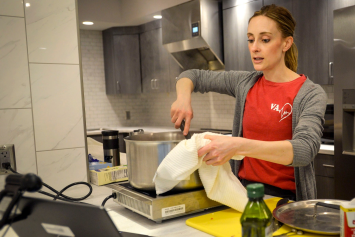Eating for Kidney Health
Tips and recipes for a kidney-friendly eating style
 Kidneys work 24 hours a day, 7 days a week. They clean your blood and keep key nutrients at the right levels for your body. When kidneys don’t work as they should, your whole body can feel the impact.
Kidneys work 24 hours a day, 7 days a week. They clean your blood and keep key nutrients at the right levels for your body. When kidneys don’t work as they should, your whole body can feel the impact.
Kidney disease or kidney failure may result from other health conditions such as diabetes or high blood pressure. If you have kidney disease, adapting your diet may help prolong kidney function. Your health care team will help you find the right balance for nutrients like sodium, potassium, protein, and phosphorus. In some cases, limiting these can help ease the burden on your kidneys.
Sodium: A high-sodium diet may raise blood pressure, make some medicines less effective, and lead to quicker loss of kidney function. Healthy eating styles contain less than 2,300 mg of sodium a day. Sodium is found in table salt and in food additives so reading nutrition facts is important.
Potassium: Your body needs potassium. But if your kidneys aren’t working as well as they should, they can’t remove excess potassium. Certain medications, nutritional supplements, health conditions, and foods can affect your potassium levels. If your blood potassium level is too high or low, your health care provider may recommend medication or dietary changes.
Protein: Limiting animal proteins from meat, poultry, eggs, fish, and cow’s milk can help slow kidney failure. Your health care provider will calculate the amount of protein you need each day. This may change based on how well your kidneys are working.
Phosphorus: As kidney function decreases, your body may not be able to remove excess phosphorus. If phosphorus builds up in your blood, calcium may be pulled out of your bones. This may also impact heart health. To keep your bones and heart strong, limit foods high in phosphorous, like cola drinks, processed meats, and fast food. Read the Nutrition Facts label and ingredient list for sources of phosphates.
Fluids: Healthy kidneys balance the amount of fluid that enters and leaves the body. If your kidneys can't maintain this fluid balance, you may need to limit your fluid intake. Measuring the amount of fluid you consume from foods (soup, popsicles, ice cream, gelatin) and drinks during the day can help.
What can you eat?
Choose fresh or homemade foods as often as possible. If you’re limiting protein, you may need to add olive oil or another healthy fat to get enough calories. You don’t have to be a vegetarian to eat more fruit, vegetables, and whole grains. These provide a better quality and variety of nutrients.
Try this kidney-friendly recipe to get started.
Bean and rice skillet with zucchini
This one-pot meal has a healthy dose of dietary fiber that will fill you up. It’s a well-balanced, nutritional meal for kidney health. It’s also low in saturated fat for heart health.
Find more kidney-friendly recipes on VA’s eKidney Clinic Nutrition Room
How My HealtheVet can help
A dietitian can help you make a meal plan that focuses on kidney health. Get started with a Secure Message to your health care provider and ask to talk about your treatment. By working together as a team, you’ll be able to better manage your kidney disease.
Learn more about Secure Messaging
Sign in to manage your health care
In 2025, you'll need to use a Login.gov or ID.me account to sign in to My HealtheVet and other VA tools.
You must be a VA patient to access some parts of your VA health record. If you’re not enrolled in VA health care, you can apply now.
Learn how to apply for VA health care
Please vote in our unscientific poll. All responses are anonymous.
Read More
Learn more about living with chronic kidney disease
Learn more about living with kidney disease on the Veterans Health Library
Updated January 17, 2025

